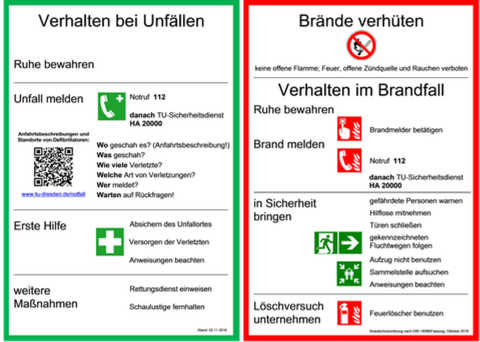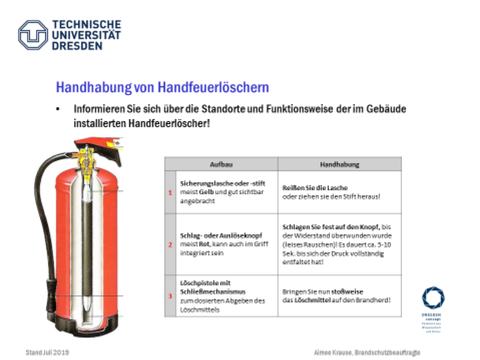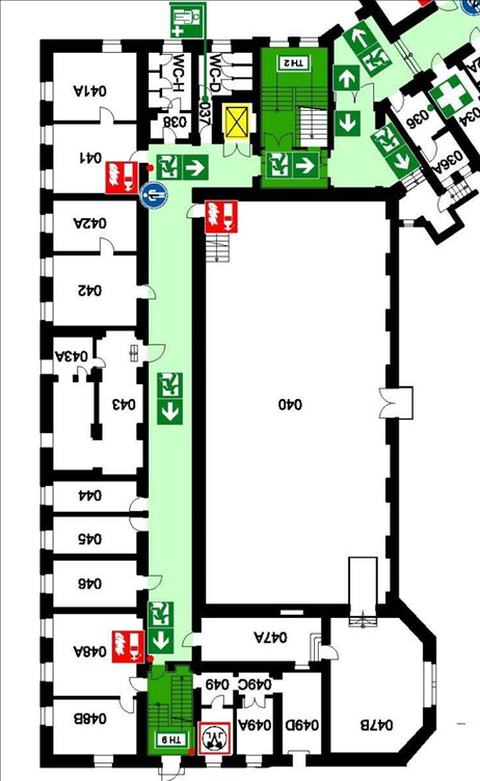Instruction for KL
Table of contents
- Instruction for course instructors
- § 1 Contract
- § 2 Settlement of the teaching assignment
- § 3 KL consultations
- § 5 Attendance list, participation ticket
- § 6 Sports facility, material and sports equipment
- § 7 Course location
- § 8 Instructions from the instructor
- § 9 Substitute teacher
- § 10 Accidents, insurance
- § 11 Corona protective measures
- Health and safety instruction for course instructors
- Instruction for course instructors
Instruction for course instructors
§ 1 Contract
Each course instructor (KL) must have concluded the teaching contract (UA) with their sport supervisor by the end of the 4th week of lectures at the latest or within 14 days of receipt.
Prerequisites for the UA are
- an agreement between the:sport supervisor and the:KL on the scope of the assignment (day, time, location), the type of assignment (type of sport, type of course)
- a current first aid certificate
- if available, proof of qualification (trainer licenses, etc., will be taken into account for remuneration)
The participant is responsible for completing the UA! The deadline for completing the UA must be adhered to. Backdating and fee settlements are no longer possible thereafter.
§ 2 Settlement of the teaching assignment
The statement of account must be submitted to the person responsible for the sport together with the instruction and attendance lists. It can be handed in after the last lesson at the earliest and must be handed in at the end of the semester at the latest. Only hours worked will be invoiced. As a rule, missed lessons can be made up for after consultation with the:sports coordinator and then billed. Each line must be written out on the statement. Do not use a pencil!
§ 3 KL consultations
All the clubs should make it possible for them to take part in the club consultations in the sport. In the
If they are unable to attend, inform them in good time and subsequently inform them of the content.
§ 4 Instruction of the participants (TN). At the beginning of the semester (usually in the first lesson of the course), each CB is obliged to point out that they are aware of this, e.g. via the DHSZ homepage (attention: latecomers!). The participant is obliged to adhere to these instructions himself/herself and to ensure that the participants also adhere to these instructions.
§ 5 Attendance list, participation ticket
Every MC is obliged to keep an attendance list for each course. This also includes checking the student ID and payment of the participants.
The attendance list also serves as proof of attendance in the event of an accident and for contact tracing in accordance with the Corona Protection Ordinance.
§ 6 Sports facility, material and sports equipment
The instructor is obliged to check the sports facility, material and equipment for safety and suitability at the beginning of each class. In the event of damage, the person responsible for the sport must be informed.
At the end of the course unit, used equipment and materials etc. must be tidied up properly!
§ 7 Course location
Courses take place in the designated sports facility throughout the semester. A change of location within the semester is not possible, except in the event of accidents or similar incidents (see GTC § 9 para. 5) or in exceptional cases after prior consultation with the person responsible for the sport.
Outdoor sports: In dangerous conditions (weather etc.), the course must be postponed or canceled for safety reasons.
§ 8 Instructions from the instructor
The coaches shall follow the instructions of DHSZ employees and authorized persons (e.g. employees of the sports facility). The instructor is authorized to issue instructions to the participants. Irrespective of this, each participant is required to perform exercises according to their personal capabilities and only take reasonable risks. Participants with health problems that could lead to acute conditions (e.g. diabetes, epilepsy) are asked to inform the instructor about this and about the necessary first aid measures. This also applies to pregnant women to avoid risky exercises.
If medication is administered, only support may be provided. This information is subject to
confidentiality. The instructor adapts the course design to the average ability of the participants. In the event of unsuitability, participants may be expelled from the course by the instructor.
§ 9 Substitute teacher
In order to avoid missed appointments, the instructor shall ensure that an adequate replacement is found by another DHSZ instructor (usually of the same sport) as soon as possible if the instructor is unable to attend. This applies in particular to short-term, one-off substitutions. Please coordinate long-term substitutions with the person responsible for the respective sport at the DHSZ. If, at short notice, a substitution is made by the
If no substitution can be found at short notice by the:coach himself/herself and even after consultation with the:person responsible for the sport, the:coach is responsible for canceling the course date.
§ 10 Accidents, insurance
Only participants who are students and employees of the affiliated universities (excluding civil servants) are insured against accidents in accordance with the conditions of Unfallkasse Sachsen. External participants are not insured.
An accident must be reported to the KL and the DHSZ as soon as possible by the accident victim him/herself or, if applicable, by a person authorized by him/her. In the event of a medical consultation, a transit doctor must be consulted. The KL is responsible for recording the accident (using the accident form). The accident form must also be completed in cases of doubt and must be signed by the employee. Once the form has been completed, the:the KL must send it to the DHSZ by email (as a photo/scan) or by mailbox (sports facilities ABS, Lower Austria). If sent by e-mail, the original document must be submitted to the DHSZ within three days (by the participant or the SC).
KL are only insured against liability, but not against accidents. It is recommended that participants take out private accident insurance.
Notes on the procedure for providing assistance in the event of an accident
§ 11 Corona protective measures
All DHSZ sports courses are conducted in accordance with the current regulations of the Federal Republic of Germany, the Free State of Saxony and TU Dresden. The course instructors are obliged to inform themselves about this and to take the necessary measures.
Health and safety instruction for course instructors
Check in advance
- Where the first aid kit is located
- Where the fire extinguisher and possibly the fire alarm button are located
- Where the telephone is located / own telephone available
- Know the emergency numbers 112 and the TU security service: 0351/ 463-20000 or Falkenbrunnen: (0*) 0351 463-34515
- Where the emergency exits and assembly point are located
- Know the correct address of the sports facility so that you can communicate it to the emergency services
What to do in the event of an accident/fire
Alerting via manual call points
Red fire alarms:
- immediately alert the fire department and, as a rule, the building users via sirens or voice announcements.
- After the detector has been triggered, always inform the TU security service on the in-house telephone (HA) 20000 (or 0351/463-20000).
Blue manual call points (house alarm):
- only trigger an alarm in the building (house alarm), which does not trigger an alarm to the fire department.
- After the alarm has been triggered, always call 112 and HA 20000 (or 0351/463-20000).
- Leave heavily smoke-filled rooms bent over or crawling
- If the escape route is filled with smoke, stay in the room, close the door and make yourself heard at the window
Use the portable fire extinguisher
- Bring the fire extinguisher close to the source of the fire: walk towards the fire in the direction of the wind!
- Hold the extinguisher vertically and always extinguish the fire from front to back and from bottom to top
But: Dripping and flowing fires must be extinguished from top to bottom! - Do not disperse burning liquids with the extinguishing jet
- If there are several fire extinguishers, use them simultaneously and not one after the other
- Keep an extinguishing reserve and watch out for possible re-ignition!
Personal fire
- Basically, act quickly! --> Use hand-held fire extinguishers if possible (unless emergency showers are available)
- CO2 extinguishers should only be used if no other extinguisher (water, foam, powder) is available.
- Prevent the burning person from running away and ask them to close their eyes and mouth
- Keep a minimum distance of 1.5 m from the burning person
- Aim the first extinguishing impulse at the upper body (protects the neck and head from flames flaring up), then direct the extinguishing jet further down the body and to the sides --> Never aim the extinguishing jet directly at the face and never linger on one part of the body (risk of frostbite!)
Fire and smoke protection doors
- Fire and smoke protection doors are self-closing room closures that are installed in walls with fire protection requirements.
- Their purpose is to prevent the passage of fire and/or smoke for a certain period of time.
- They therefore only function as intended when they are closed. Fire doors must not be wedged, tied or otherwise forced open! Do not place any devices or similar in front of them
- In many cases, modern fire doors are linked to a smoke detector.
- They have a combination of hold-open system and door closer. If the smoke detector triggers an alarm, the door is closed automatically. These doors may remain open during normal operation.
- Do not block escape doors etc. with devices, these must remain free!
Collection point at Weberplatz
Afterwards
- Report the accident to Karola Hartmann (safety officer): or the fire to the fire safety officer Angela Schuster-Jirka:



